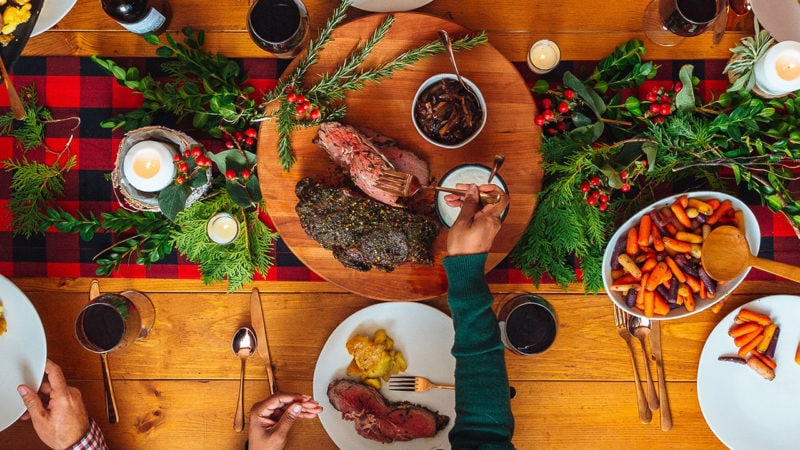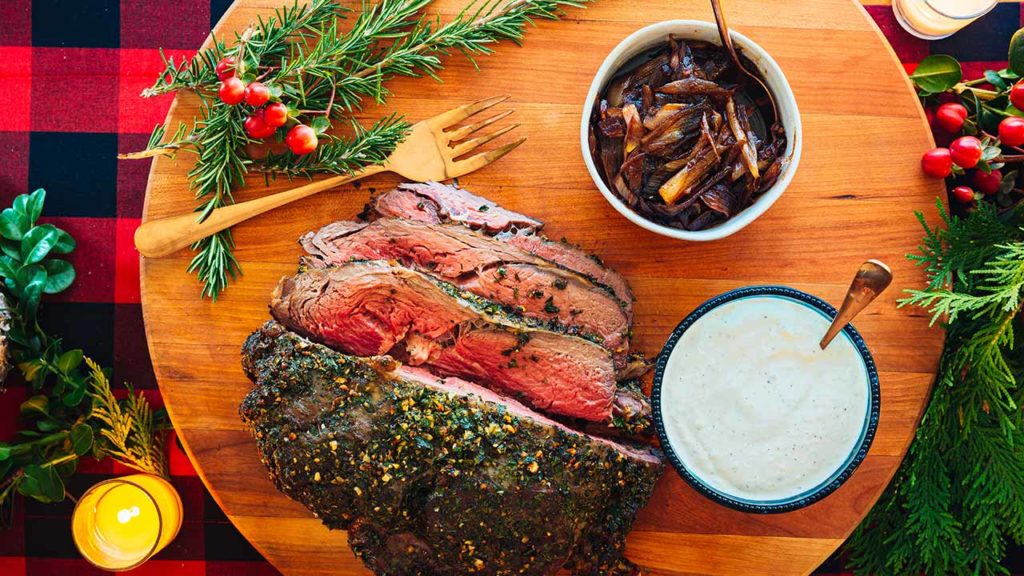Last Updated on November 19, 2021
Ribeye roast. The name itself evokes visions of a meat centerpiece right out of Dickens’ A Christmas Carol. So it’s no wonder that this special cut of beef is often saved for holiday meals or family dinners.
It’s deliciously indulgent, so it makes sense that we save it for only the most celebratory of occasions. In this guide, we’ll talk you through everything you need to know to prepare a perfect ribeye roast, no matter what you might be celebrating.
You’ll learn:
- Where the ribeye roast comes from
- The difference between prime rib, ribeye roast, and standing rib roast
- How to prepare a ribeye roast
- Perfect ribeye roast recipes to get you started
If you’ve decided to make a beefy, juicy ribeye roast this season, this guide’s for you.
What is Ribeye Roast?
You know and love ribeye steaks, and ribeye roasts take everything great about ribeye steaks a step further. They’re the king-sized version of the king of steaks.
Cut from the center of the rib section, ButcherBox’s grass-fed, grass-finished ribeye roasts are breathtakingly marbled and tender. This roast boasts a buttery smooth texture and rich beefy flavor.
Ribeye roasts are a mainstay at special-occasion meals, like the holidays, or family Sunday dinners. But, you can make a ribeye roast work for everyday fare by slicing it into individual steaks.
You’ve likely heard a few different names for ribeye roast, like prime rib, or standing rib roast. These names are often used interchangeably, and they are quite similar. Ribeye roast and prime rib are effectively the same thing. Standing rib roast comes from the same cut of the animal, but traditionally retains the bones (hence, the “standing” part).
Whatever you decide to call your ribeye roast, one thing is for sure: This roast is a thing of beauty, and yields a buttery smooth, pink interior and deliciously crusted exterior when cooked properly. Let’s talk some more about the best way to prepare a ribeye roast.
How to Prepare Ribeye Roast
If you’re looking to cook a ribeye roast whole, you’re going to want to, well, roast it. You can wet rub it or rub it down with a delectable compound butter made from all manner of things, but there are some basics you’ll want to keep in mind.
1. You’ll need to vary the oven temperature. In order to achieve a crusty exterior and tender pink interior, you’ll have to play with oven temperatures a bit. There are a couple of ways to achieve this.
- You could start out low and slow, at around 225°F for 90 minutes (or more, depending on size). Then, allow it to rest for 30 minutes, or up to 2 hours. Crank up the oven to 425°F and roast it for another 20 minutes. Let it rest again.
- Or, you can reverse the process. Start your roast at 400°F in the oven for about 20 minutes, fat side up. Then, reduce the temperature to 325°F for 40 minutes (or longer, depending on size). Let the meat rest and serve it with your favorite accompaniments.
2. Season liberally. While steaks are often wonderful with little more than salt and pepper, ribeye roasts offer a great opportunity to build a flavor-packed crust on the outside. So, try a rub with ingredients like salt, thyme, garlic, and Dijon. Or, make a compound butter with garlic and your favorite herbs. Whatever you do, don’t skimp on any of it.
3. Do not overcook it. Ribeye roast is a thing of beauty, and for maximal tenderness, you want to aim for a perfectly pink interior. Medium-rare is the ideal here. To achieve that, cook your grass-fed roast to 120°F-125°F internal temperature, keeping in mind that it will carry-over cook while it rests.
4. Let your roast rest. Don’t cut into your ribeye roast straight out of the oven. Just don’t do it. Give it ample time to let the juices redistribute and yield you buttery-tender and juicy meat. You can let your roast rest for 15 minutes, all the way up to 2 hours.
Ribeye Roast Recipes to Get You Started
Ready to dive into cooking your own roast at home? Here are a couple great recipes we recommend:
Easy Holiday Ribeye Roast
Great for beginners, this ribeye roast will be the star of your holiday spread (or Sunday night dinner, either way).
We opt for a wet rub here, combining minced garlic, minced shallots, Dijon mustard, fresh thyme, olive oil, salt, and pepper. Rub this on the roast the night prior, and let it seep in overnight, covered in plastic.
When you’re ready to move it into the oven, sprinkle the ribeye roast with a bit more salt and pepper. This recipe calls for starting out low and slow at 225°F, and its instructions are straightforward and easy to follow.
If you’re hoping to keep the ribeye roast nice and easy, this is the recipe for you.
Garlic and Herb Crusted Ribeye Roast with Horseradish Cream and Bacon Shallot Marmalade
If you want a roast that really ups the ante, this garlic and herb-crusted ribeye roast should do it.
While it may sound like this meal packs in a lot of components, all of them are very doable. So, while impressive, this meal is not intimidating.
You’ll want to make a wet rub for this roast, combining garlic, rosemary, parsley, salt, pepper, and avocado oil. We crank up the heat for this recipe to build a delicious crust, then lower it for its remaining cook time.
While the roast cooks, you’ll prepare delicious accompaniments, including horseradish cream and bacon shallot marmalade.
Combining prepared horseradish with mayonnaise, greek yogurt, and a bit of pepper cuts down the intensity of the horseradish. Meanwhile, the sweet and tangy balsamic-based bacon shallot marmalade adds so many layers of flavor, your guests will savor each bite.




